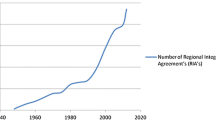Abstract
During the 1980s, increasing numbers of developing countries unilaterally liberalized their trade regimes. This paper presents an overview of this dramatic shift from protectionism toward freer trade. South Asia, Latin America, and East Asia have implemented extensive reforms, yet each region has shown a distinct difference in approach and in the degree of liberalization actually achieved. Latin America stands out as moving sharply toward the level of openness of the East Asian Newly Industrialized Countries (NICs). Only in Africa is there little progress toward freer trade.
Similar content being viewed by others
References
Alam, A. and Sarath Rajapatirana (1993) “Trade Policy Reform in Latin America and the Caribbean in the 1980s,” World Bank Policy Research Working Paper No. 1104.
Anderson, J. and J.P. Neary (1994) “Measuring the Restrictiveness of Trade Policy,”World Bank Economic Review 8, 151–169.
Bhagwati, J. (1988) “Export Promoting Trade Strategies: Issues and Evidence,”The World Bank Research Observer 3, 27–58.
Corden, W.M. and Rodney Falvey (1985) “Quotas and the Second Best,”Economics Letters 18, 67–70.
Dean, J., S. Desai, and J. Riedel (1994) “Trade Policy Reform in Developing Countries Since 1985: A Review of the Evidence,” World Bank Discussion Paper No. 267.
Dornbusch, Rudiger (1992) “The Case for Trade Liberalization in Developing Countries,”The Journal of Economic Perspectives 6, 69–86.
Edwards, Sebastian (1989) “Openness, Outward Orientation, Trade Liberalization and Economic Performance in Developing Countries,” The World Bank.
Edwards, Sebastian (1989) “The Sequencing of Economic Reform: Analytical Issues and Lessons from Latin American Experiences,”World Economy 13, 1–14.
Falvey, Rod and Cha Dong Kim (1992) “Timing and Sequencing Issues in Trade Liberalization,”The Economic Journal 102, 908–924.
Greenaway, David (1993) “Liberalizing Foreign Trade through Rose-Tinted Glasses,”The Economic Journal 103, 208–222.
Harrison, A. (1991) “Openness and Growth: A Time Series, Cross Country Analysis for Developing Countries,” World Bank Background Paper, World Development Report 1991.
Krueger, Anne (1986) “General Issues in Economic Liberalization.” In A. Choksi and D. Papageorgiou (eds),Economic Liberalization in Developing Countries. Oxford: Basil Blackwell, pp. 147–204.
Leamer, Edward (1988) “Measures of Openness.” In Robert Baldwin (ed),Trade Policy Issues and Empirical Analysis, a National Bureau of Economic Research Conference Report. Chicago: University of Chicago Press, pp. 147–204.
Michaely, Michael (1986) “The Timing and Sequencing of a Trade Liberalization Policy.” In A. Choksi and D. Papageorgiou (eds),Economic Liberalization in Developing Countries. Oxford: Basil Blackwell, pp.
Nash, John (1993)Implementation of Trade Reform in Sub-Saharan Africa: How Much Heat and How Much Light? Policy Research Working Paper 1218, World Bank, Trade Policy Division.
Nogues, Julio and S. Gulati (1992) “Economic Policies and Performance under Alternative Trade Regimes: Latin America During the 80s,” World Bank Latin America and Caribbean Technical Department Regional Studies Program, Report No. 16.
Papageorgiou, D., M. Michaely, and A. Choksi (1991)Liberalizing Foreign Trade, Vol. 7: Lessons of Experience in the Developing World. Oxford: Basil Blackwell.
Pritchett, Lant (1991) “Measuring Outward Orientation in Developing Countries. Can It Be Done?” World Bank Policy Research Working Paper No. 566.
Rodrik, Dani (1992) “The Limits of Trade Policy Reform in Developing Countries,”The Journal of Economic Perspectives 6, 87–105.
Rodrik, Dani (1993) “Trade and Industrial Policy Reform in Developing Countries: A Review of Recent Theory and Evidence,” NBER Working Paper No. 4417.
Thomas, V. and J. Nash and Associates (1991a)Best Practices in Trade Policy Reform. Oxford: Oxford University Press.
Thomas, V. and J. Nash and Associates (1991b) “Reform of Trade Policy: Recent Evidence from Theory and Practice,”World Bank Research Observer 6, 219–240.
UNCTAD (1987)Handbook of Trade Control Measures of Developing Countries: Supplement.
World Bank (1992)Trade Policy Reforms under Adjustment Programs. World Bank Operations Evaluation Department.
World Bank (1993)Adjustment in Africa: Reform, Results, and the Road Ahead. A World Bank Policy Research Report, Washington, D.C.
Author information
Authors and Affiliations
Rights and permissions
About this article
Cite this article
Dean, J.M. From protectionism to free trade fever? Recent reforms in developing countries. Open Econ Rev 6, 369–385 (1995). https://doi.org/10.1007/BF01000388
Issue Date:
DOI: https://doi.org/10.1007/BF01000388




